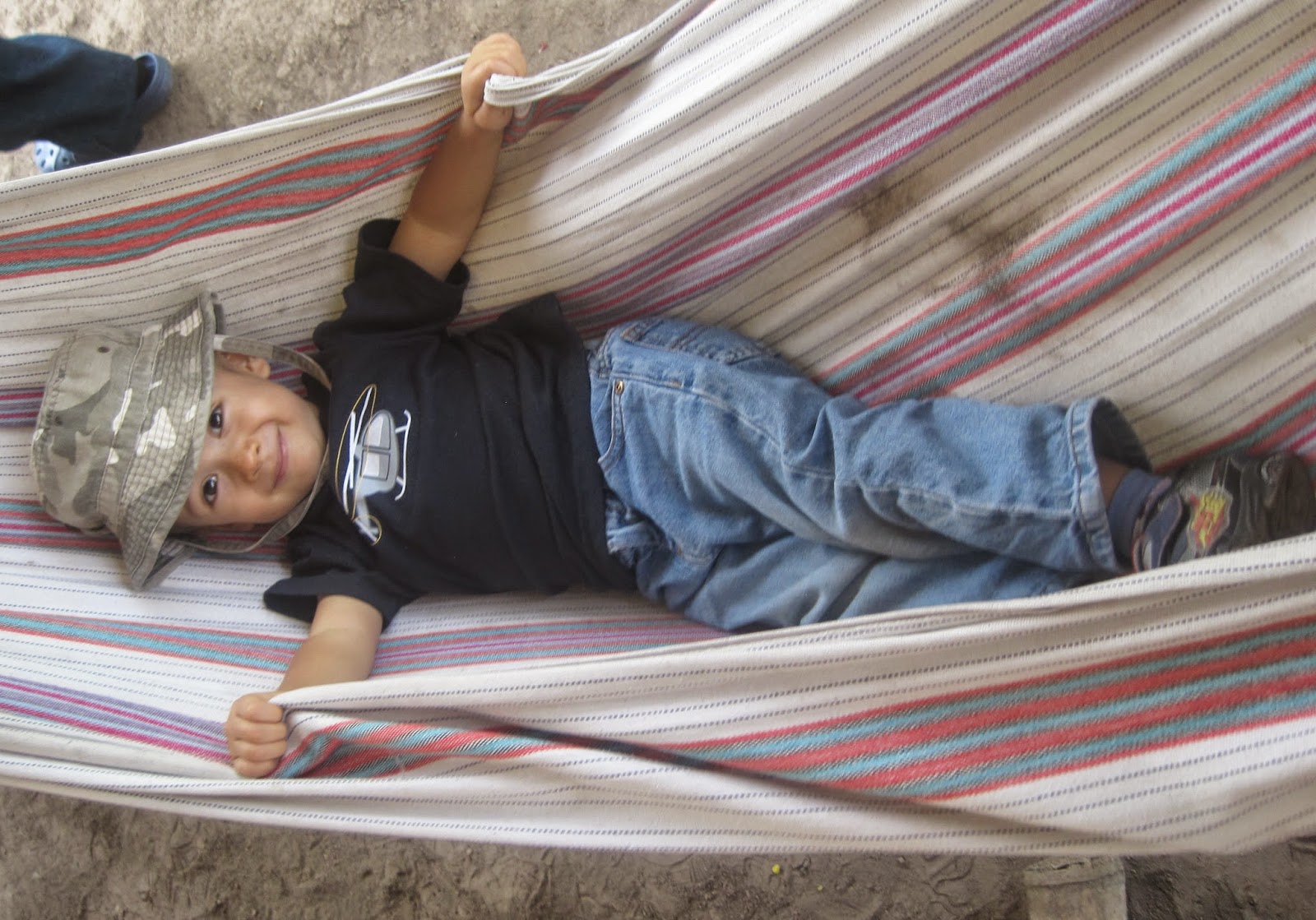Day of the Dead (Finados) 2014, Part 1
We spent the Day of the Dead, or finados as it is called here in Ecuador, in Santa Rosa with Marisol's family. It is a Catholic holiday, All Souls Day, which is the two days after Halloween, or All Hallows (Holy) Eve which was later shortened to Halloween. The day after Halloween is All Saints Day, which is why All Hallows Eve is considered sacred or holy.
Here Elías is celebrating in his abuelito's hammock in Santa Rosa.
While cousin Cloe and Jacob look on from their lookout in the nearby playhouse.
Baby cousin Antonito rested in the other hammock.
Antonito and proud sister Cloe.
Proud cousins Joel and Jacob with Antonito who was born in July.
Morgan and Joel look on while Marisol's sister Negui and her mom Zulema transport the colada morada from the smoke house to the kitchen.
Elías hides in the hammock.
Morgan and Joel sample the colada morada.
Colada morada is made once a year for the Day of the Dead. It is a drink with brown sugar, lemon grass, lemon verbena, orange leaves, myrtle, blueberries, blackberries, pineapple, strawberries, babaco, purple corn flour, allspice, and many other ingredients. It is absolutely divine, especially my mother-in-law's.
This tradition dates from over 1000 years ago when the Quitu-Cara prepared a drink with spiritual symbolism to honor the dead, made with corn and llama blood. Sounds interesting. Over the years this tradition evolved into the colada morada. (No, we do not drink llama blood!)
The other staple for the celebration is bread. Marisol's family makes regular bread, sweet bread, corn bread and cheese turnovers. It is an all-day affair.
Here I am with Elías and Cloe.
Jacob climbed a tree by himself for the first time. He was so proud of himself, and rightly so.
The bread baking begins with Marisol's sister-in-law Gisela, Zulema, Morgan and Negui.
Later Joel joined in the fun.
While Marisol's father Wilson greased the table surface for molding the bread.
Part of the process is making little human and animal figures from the bread dough.
Amelia was so pleased with her bread girl.
Cousin Zoe and Marisol took their turns as well.
With Gisela, Antonito and cousin Carolina.
Elías with the pan of bread figures.
The Incas often disinterred the dead, in the form of mummies, and moved them around to cool off in the rain and fill them with "new energy." This custom became taboo during the Spanish colonial period. Later the dead were represented by a corn tortilla in the form of a human without arms and legs, which can be seen in the "guagas de pan" or bread dolls now popular for the Day of the Dead.
My guinea pig is there at the top left. He ended up looking more like a bear after baking.
Marisol takes the tray out of the oven.
Marisol's aunt Mayri and her abuelita take over the "second shift" of bread making.
Bread and colada morada are served! Yum, YUM, yummy!
Jacob taste tests the bread.
Elías hugs his bread horsey!
Here Elías is celebrating in his abuelito's hammock in Santa Rosa.
While cousin Cloe and Jacob look on from their lookout in the nearby playhouse.
Baby cousin Antonito rested in the other hammock.
Antonito and proud sister Cloe.
Proud cousins Joel and Jacob with Antonito who was born in July.
Morgan and Joel look on while Marisol's sister Negui and her mom Zulema transport the colada morada from the smoke house to the kitchen.
Elías hides in the hammock.
Morgan and Joel sample the colada morada.
Colada morada is made once a year for the Day of the Dead. It is a drink with brown sugar, lemon grass, lemon verbena, orange leaves, myrtle, blueberries, blackberries, pineapple, strawberries, babaco, purple corn flour, allspice, and many other ingredients. It is absolutely divine, especially my mother-in-law's.
This tradition dates from over 1000 years ago when the Quitu-Cara prepared a drink with spiritual symbolism to honor the dead, made with corn and llama blood. Sounds interesting. Over the years this tradition evolved into the colada morada. (No, we do not drink llama blood!)
The other staple for the celebration is bread. Marisol's family makes regular bread, sweet bread, corn bread and cheese turnovers. It is an all-day affair.
Here I am with Elías and Cloe.
Jacob climbed a tree by himself for the first time. He was so proud of himself, and rightly so.
The bread baking begins with Marisol's sister-in-law Gisela, Zulema, Morgan and Negui.
Later Joel joined in the fun.
While Marisol's father Wilson greased the table surface for molding the bread.
Part of the process is making little human and animal figures from the bread dough.
Amelia was so pleased with her bread girl.
Cousin Zoe and Marisol took their turns as well.
With Gisela, Antonito and cousin Carolina.
Elías with the pan of bread figures.
The Incas often disinterred the dead, in the form of mummies, and moved them around to cool off in the rain and fill them with "new energy." This custom became taboo during the Spanish colonial period. Later the dead were represented by a corn tortilla in the form of a human without arms and legs, which can be seen in the "guagas de pan" or bread dolls now popular for the Day of the Dead.
My guinea pig is there at the top left. He ended up looking more like a bear after baking.
Marisol takes the tray out of the oven.
Marisol's aunt Mayri and her abuelita take over the "second shift" of bread making.
Bread and colada morada are served! Yum, YUM, yummy!
Jacob taste tests the bread.
Elías hugs his bread horsey!



































Comments